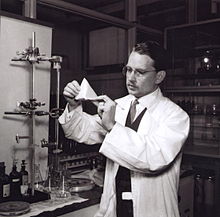Aseptic processing
[1] Aseptic processing has almost completely replaced in-container sterilization of liquid foods,[2] including milk, fruit juices and concentrates, cream, yogurt, salad dressing, liquid egg, and ice cream mix.
[4] Aseptic processing was derived from Olin Ball's heat-cool-fill (HCF) machine that was developed in 1927.
The food treated using this technique was described as an "excellent cream product" and 75–100 containers were produced each minute.
[5] The foods processed ranged from soups to specialty sauces, fruits, and dairy products.
The Dole aseptic machine overcame the hindrances that caused HCF's failure, since it was able to process various container sizes, needed less maintenance time and cost less.
The lack of consumer interest drove foods that were processed in the Dole aseptic machine to be discontinued.
The milk that was drawn from the cow went through a pipeline, into a vacuum tank, which was then heated to 285 °F, then cooled to room temperature.
The product, packaged in metal cans, was widely accepted by consumers lacking access to fresh milk, including the U.S.
This is advantageous because it allows for faster processing, usually a few seconds at high temperatures (130–150 °C) and better retention of sensory and nutritional characteristics.
[7][8] UHT food products can be sterilized using either direct or indirect methods of heat transfer.
It can process higher viscosity foods compared to steam injection, but risks the blockage of nozzles in machinery.
Tubular and scraped-surface can heat viscous food with particulates or high pulp content with minimal damage.
[8] To achieve this, a laminate material is formed from the following components: semi-rigid paper, aluminum, and plastic.
[3] Paper (70%) provides the stiffness, strength, and the efficient brick shape to the package; potential for bacteria needs to be addressed.
Aluminum (6%) is located on the inside of the aseptic package, forming a barrier against light and oxygen, thereby eliminating the need for refrigeration and preventing spoilage without using preservatives.
The following factors may influence the choice of packaging material for aseptically processed products: functional properties of the plastic polymer (gas and water vapor barrier properties, chemical inertness, and flavor and odor absorption or scalping), potential interactions between plastic polymer and food product, desired shelf life, economical costs, mechanical characteristics of the packaging material (molding properties, material handling characteristics, and compatibility with packaging and sterilization methods), shipping and handling conditions (toughness, compression), compliance with regulation, and targeted consumer group.
[3] Preformed cups, tubs, trays, and bottles Operation flexibility, container quality able to be checked in advance Aseptic processing preserves food quality through fast heat treatment followed by a short holding time and rapid cooling.
This depends on the amount of reducing sugar, the formation of pyralysins and melanoidins, the severity of the treatment, and the storage temperature.
[1] Aseptic processing costs more than canning because sterilization of the packaging materials requires different machinery and can get complex.
The FDA has also developed a Low-acid Canned Food (LACF) Electronic Process Filling System that facilitates the completion and submission of the forms.
The FDA may request sufficient technical information from the processor to evaluate adequacy of the equipment and the procedures used to produce a commercially sterile product.
Until the FDA finds no further objections to a process filing, the company is prevented from distributing product produced on that system in interstate commerce.
[15] The FDA relies on periodic inspections of processing plants to monitor compliance with its regulatory requirements.

